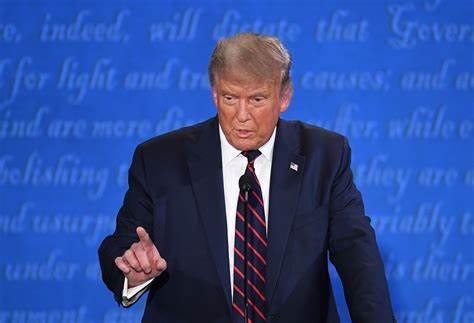The U.S. dollar faced its steepest drop since November 2023, as global markets reacted to President Donald Trump’s ambiguous stance on trade tariffs. The dollar index, which measures the strength of the U.S. currency against a basket of six other major currencies, fell by as much as 1.3% by late afternoon in New York, signaling investor uncertainty over Trump’s trade policy direction.
The sharp drop in the value of the dollar occurred in the wake of Trump’s inauguration speech, during which he reiterated his intent to impose tariffs on foreign countries, saying, “We will tariff and tax foreign countries to enrich our citizens.” However, Trump refrained from providing further details about how these tariffs would be structured or which nations would face immediate sanctions. This lack of clarity left the currency markets in a state of heightened speculation and confusion.
Despite the dramatic rhetoric, White House officials clarified that Trump would first conduct reviews of existing trade agreements with Mexico, Canada, and China before proceeding with any new tariffs. This decision to delay immediate tariff actions contributed to the unexpected weakness in the U.S. dollar, as traders had hoped for a clear and immediate action plan.
JPMorgan Chase strategist James Nelligan highlighted that the dollar’s sharp decline reflected a short-term disappointment from investors who had expected more decisive action on tariffs. “No tariff implementation immediately… would be a short-term disappointment for the dollar, and it has understandably knee-jerked weaker in sympathy,” he said. This reflected broader market skepticism, with investors unsure about Trump’s next moves and the potential impact of his trade policies.
Nelligan went on to emphasize that the dollar could experience further volatility if Trump moves forward with aggressive tariffs later on. “There’s still scope for potentially aggressive tariffs down the line once the reviews of trade relationships by federal agencies have taken place,” he stated. The markets now anticipate that, while tariffs may not be immediately imposed, the uncertainty surrounding the future of U.S. trade relations will continue to contribute to volatility in the coming months.
The currency market’s reaction to Trump’s rhetoric was evident across major global currencies. The British pound, euro, Mexican peso, and Canadian dollar all surged against the weakening U.S. dollar. For instance, the Mexican peso gained more than 1.1% against the greenback, as the country’s economy remains particularly sensitive to shifts in U.S. trade policies.
Brad Bechtel, global head of FX at Jefferies, explained that the dollar had been in a “very overbought” position for several weeks, and this correction was long overdue. “A correction was coming,” Bechtel remarked, referring to the market’s long-standing overvaluation of the dollar. The shift in the dollar’s trajectory was further amplified by recent trends in U.S. government bond sales, which have been driven by expectations of inflation due to Trump’s proposed tariffs and tax cuts. As inflationary pressures mount, the Federal Reserve may feel compelled to keep interest rates higher for longer, a scenario that investors have already factored into their market positions.
While the U.S. dollar faced significant turbulence, European equity markets showed a more positive response. The Stoxx Europe 600, a broad measure of European stocks, closed up 0.1%, with major indices in Germany and the U.K. also posting gains. Germany’s DAX rose by 0.4%, while the U.K.’s FTSE 100 added 0.2%, reaching a fresh record high. These movements suggest that European investors may be less concerned by the immediate impacts of Trump’s trade rhetoric, at least in the short term.
One key factor in this resilience was the European markets’ relative detachment from the U.S. dollar’s fortunes. European stocks are often less correlated with the U.S. dollar than other global markets, allowing them to thrive despite the uncertainty created by Trump’s policy stances. Still, the potential for increased volatility as trade negotiations unfold remains a concern for investors across the globe.
On the commodities front, oil prices took a notable hit after President Trump’s inaugural speech, which included remarks about declaring an “energy emergency” and opening up federal lands for expanded oil exploration. The move was seen as part of Trump’s broader strategy to boost U.S. energy production, potentially making the country less reliant on foreign oil. However, the immediate reaction from the oil market was a decrease in prices, with Brent crude falling 0.9% to $80.03 per barrel, and U.S. West Texas Intermediate (WTI) crude down 1.7% to $76.58 per barrel. These declines suggest that investors remain cautious about the long-term impact of Trump’s energy policies, particularly in relation to global supply-demand dynamics.
As the markets continue to react to Trump’s economic policies, the Federal Reserve’s role remains a key focal point. With the looming threat of inflationary pressures caused by tariffs, analysts predict that the Fed may be forced to adjust its interest rate policy to accommodate the new economic landscape. The uncertainty surrounding the Federal Reserve’s future moves has added another layer of complexity to an already volatile financial environment.
The ongoing uncertainty surrounding U.S. trade policies, combined with the broader economic challenges posed by Trump’s administration, means that the global economic landscape is in a state of flux. As U.S. trade relationships with key partners like Mexico, Canada, and China remain under review, markets will be watching closely for any developments that could signal the next move in the tariff saga. In the meantime, the dollar’s weakness is expected to persist as global investors take a wait-and-see approach to the future of U.S. trade policy.
With the future of U.S. trade in question, businesses and investors alike will need to remain agile in responding to the rapidly changing political and economic landscape. The eventual outcome of Trump’s trade reviews could reshape the global economic order, but until then, volatility and uncertainty will continue to characterize the markets.



